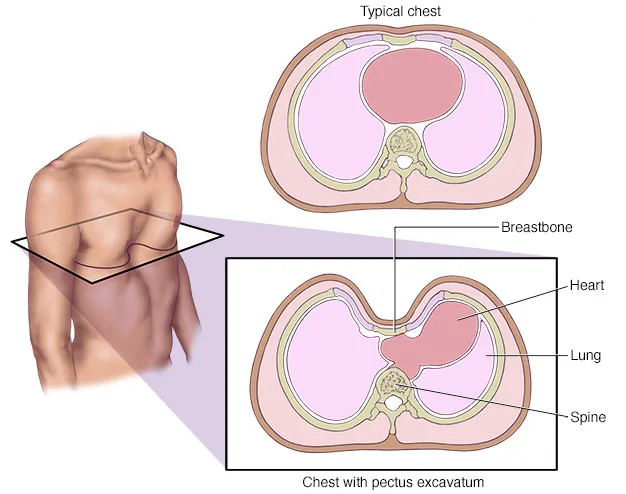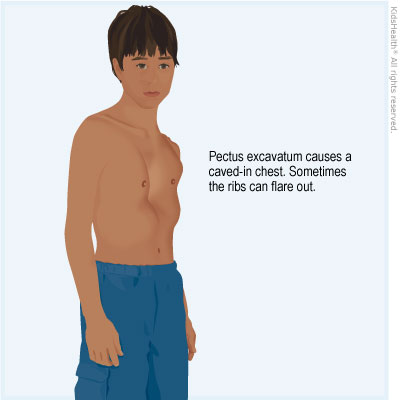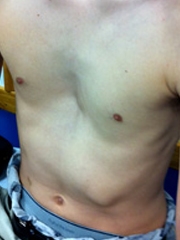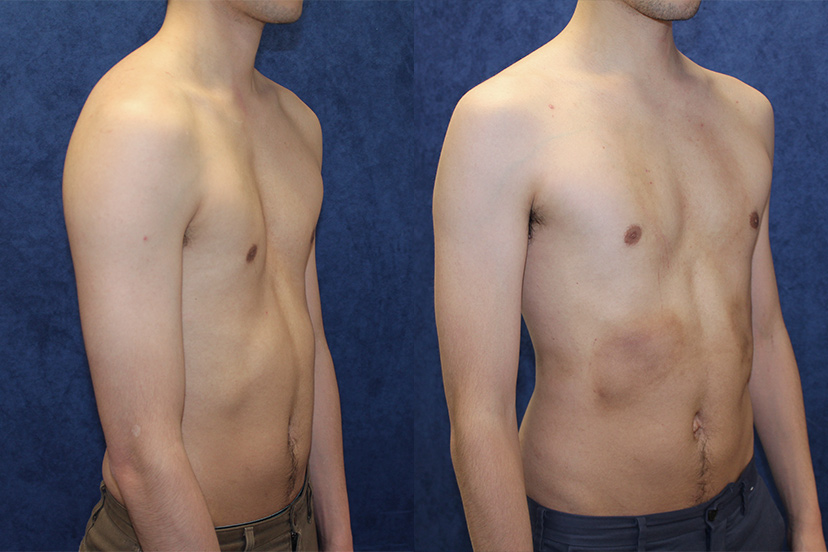pectus excavatum baby breathing
This causes the sternum to grow inward. This can cause shortness of breath with exercise.

Find An Ent Doctor Who Knows Laryngomalacia Is More Than Noisy Breathing At Copingwithlm Org Cope Supportive I Am The Doctor
A concave sternum or.

. There isnt any scientific data about pectus excavatum breathing in babies. The lower half of the breastbone may press on the heart and lungs. Having looked online I see that it can become more pronounced as baby grows.
Pectus excavatum baby breathing. The lungs and heart and great vessels can be compromised causing problems with breathing and exercise intolerance. With a severe case of pectus excavatum there can be compression of the heart.
We recently noticed that my little boys chest has a little concave dip in it when he breathes in - the GP has said that he has pectus excavatum and that as his breathing is totally fine it is nothing to worry about. Some children with funnel chest will live a normal life. PE can often be hereditary.
Miamis family soon realized her mother may also have the condition and was unaware until Miami was diagnosed. Provide slight upward rotation of the ribcage and isometric control for outward movement of the chest creates negative intrathoracic pressure 2. The primary goal of surgery for pectus excavatum is to correct the chest deformity to improve a patients breathing and cardiac function.
Pectus excavatum is generally regarded as a cosmetic deformity. Over time the chest wall stays forward on its own. Although it is not common some patients notice an improvement in their chest appearance as their muscles develop more around.
Limitation of rib cage mobility. In severe cases of pectus excavatum the chest cavity is divided almost in half by the abnormal sternum and ribs. As a result there is a depression in the chest over the sternum which may appear quite deep.
Correcting the abnormality when still young and growing a patient can return to relatively normal function and lifespan. Pediatric specialists say that newborns and infants dont have breathing troubles caused by pectus excavatum. In this nonsurgical approach the bell device is placed on the chest.
Those with moderate-to-severe condition may have symptoms such as shortness of breath fatigue exercise intolerancelimitations and chest pain. As the ribcage is more rigid than normal it can make it difficult to completely breathe out expire. That can be caused by a hard pushing of the breastbone into the lungs.
It has a male predominance with a ratio of 31 male to female 1. Should be a passive process. It is found in one in 400 live births.
Children with pectus excavatum sometimes also have scoliosis. Pectus excavatum can range from mild to severe. Feelings of depression or anger about the condition.
Pectus excavatum can be noticed at birth or early in life in some children. Ribcage problems do not usually cause problems when the heart and lungs are developing but rarely can affect how well they work in later childhood. Thats because they arent doing any strenuous physical activity.
If the condition is severe the heart and lungs can be affected. Pectus excavatum the most common anterior-chest-wall deformity is characterized by inward displacement of the sternum creating a depression in the chest. Their breathing is normal and there isnt anything to worry about.
Rarely they also have Marfan syndrome. Pectus excavatum funnel chest is when your childs breastbone is pressed inwards and they have a dip between their ribs. What to Expect at Your Office Visit.
Pectus excavatum is a congenital chest wall deformity that is caused by growth abnormality of the cartilage that connects the ribs to the breastbone sternum. Pectus excavatum a deformity of the sternum and ribs caused by an unbalanced costochondral hypertrophy is a congenital abnormality with a prevalence of 1 per 1000 patients. Pectus excavatum is due to too much growth of the connective tissue that joins the ribs to the breastbone sternum.
Mild pectus excavatum in young patients often can be treated at home with a vacuum bell device. Will my pectus excavatum get worse over time. 27072017 at 253 pm.
Repositioning the sternum to a more normal outward position lessens pressure on the heart and lungs allowing them to function more normally. Pectus excavatum is a Latin term that means hollowed chest People with this congenital condition have a distinctly sunken chest. For others it may affect their heart or lung function.
Pectus excavatum is usually noticeable soon after birth. A hollow depression in the chest that may be broad and shallow deep and narrow or irregular more rapid breathing than normal. Pectus excavatum may be mild moderate or severe.
1 2 Pectus excavatum may be associated with connective tissue disorders such as Marfan and. Pectus excavatum - dip in babys chest. Those with a mild condition often do not have symptoms.
Physiologic studies sometimes show mild restrictive changes and suggest an increased oxygen cost of breathing. Feeling tired even when not being active. It occurs mostly in boys and frequently more members in a family are affected.
The crying is closely related to chest bone pain which is one of the most common signs of pectus excavatum. This triggers diaphragm descent and abdominal outward displacement creates increased intra- abdominal pressure Exhalation. Its connected to a pump that sucks the air out of the device creating a vacuum that pulls the chest forward.
However some children with pectus excavatum complain of chest pain and exercise limitation. An infant with pectus excavatum may have other symptoms and signs that when taken together define a specific condition known as a syndrome. The opposite condition called pectus carinatum is when the chest bows outward.
Your provider will perform a physical examination. In infancy symptoms of pectus excavatum can include. Another sign for parents is coughing.
However the chest may sink in more as someone goes through growth spurts during puberty. Pectus excavatum PE is a condition where the breastbone in the chest is sunken inward causing breathing difficulties and in rare cases mild cardiac issues. Studies have shown that pectus excavatum in babies can also cause respiratory infections.
Pectus excavatum can make breathing a chore but miami didnt allow her breathing difficulties to stop her from her love for competition. The deformity may be symmetrical the same on both sides or may be more prominent on one side of the chest.

Help My Baby S Chest Is Caving In Pectus Excavatum Dr Paul Youtube

Learning About Pectus Excavatum Repair In Children

Pectus Excavatum Chest Wall Stanford Children S Health

Pectus Excavatum Pectus Excavatum Daily Medical Cases Facebook

Chest Wall Disorder Pectus Excavatum For Parents Primary Children S Hospital

Pectus Excavatum Children S Hospital Of Philadelphia

Pectus Excavatum Background Pathophysiology Epidemiology Pectus Excavatum Medical Pictures Medical

What To Know About Funnel Chest Pectus Excavatum Vacuumbell Co

Postnatal Photograph Of The Child With Pectus Excavatum Download Scientific Diagram

Pectus Excavatum Case Histories

Pectus Excavatum Chest Wall Deformities Child Heart Specialist

Pectus Excavatum Chest Wall Stanford Children S Health

Low Set Ear Camptodactyly Arachnodactyly Pectus Excavatum Flexion Download Scientific Diagram

Pectus Excavatum Chest Wall Deformities Child Heart Specialist

Riley Byrne Is A Personal Trainer And Online Coach Specialised In Helping People With Pectus Excavatum Improve Thei Pectus Excavatum Tight Muscles Tight Quads

1 Pectus Excavatum Is Often Seen In Infants This 11 Month Old Child Download Scientific Diagram


/GettyImages-955109626-4b3292cc1af6404d8e85bd1145bd1193.jpg)